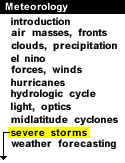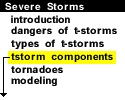
|
Vertical wind shear is the second critical factor in the determination of thunderstorm type and potential storm severity. Vertical shear, or the change of winds with height, interacts dynamically with thunderstorms to either enhance or diminish vertical draft strengths.

Photograph by: Moller
Looking north from about 15 miles, we see a storm embedded in strong vertical shear. Upper level winds near cloud summit were blowing from west to east (left to right) at 130 MPH. Surface winds were from the south at 20 MPH, indicating over 100 MPH of shear through the cloud layer! Such vertical shear often destroys all but the strongest storms by literally blowing the updraft away from its base. This nearly occurred in this case, as noted by the storm's severely tilted updraft. (It must be emphasized that cloud tilt is not always due to winds which increase in velocity with increasing height. Strong low-level winds beneath light upper-level winds will cause a cloud to slope over as the base is pushed away from the cloud tower.) Oddly, vertical shear, where winds increase or change direction with height serves to enhance rather than weaken the strongest storms, through wind removal of precipitation from the updraft summit, and in some cases introduction of updraft rotation.

Photograph by: Moller
Thunderstorms which occur in weak vertical wind shear usually have an erect appearance. These storms don't last as long as strong storms in a sheared environment since the rainy downdraft quickly undercuts and chokes off the updraft. If any severe weather occurs with these weak-shear storms, it will be brief, occurring just prior to dissipation. Weak-shear severe storms are often called "pulse storms." (Looking southeast from 20 miles.)

Updrafts/Downdrafts |
|

convection |




